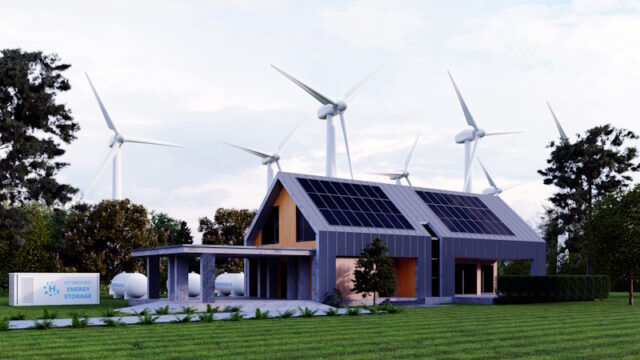
By Rachel Goldman, Advisor – SVN Commercial Advisory Group
Today’s real estate industry finds itself at a critical juncture. With climate change threats looming, coupled with rising operational expenses, professionals are adapting by embracing innovative sustainability strategies.
By implementing innovative sustainability strategies and practices, real estate professionals can combat climate change and cut costs.
Sustainable building practices
Green building design, which integrates energy-efficient materials and construction methods to curb energy use and emissions, sits at the core of this shift. Reflective roofing, high-performance insulation, and other eco-conscious elements are becoming mainstream. In addition, new technologies like LED lighting and smart climate control systems are revolutionizing efficiency. Their ability to slash energy consumption and costs makes them essential for both finances and carbon footprints.
Recognizing the broader environmental context, sustainable real estate practices also prioritize water conservation. This involves incorporating water-efficient fixtures, implementing sustainable landscaping practices, and even integrating rainwater harvesting systems into property design.
By reducing the demand for local water resources, these practices help build resilience against the water-related challenges exacerbated by climate change.
Another critical facet of sustainable building practices is passive solar design, a philosophy that optimizes a building’s orientation to maximize natural heating and cooling.
Passive solar design offers similar dual benefits by naturally leveraging the sun’s heating and cooling properties to diminish the need for mechanical HVAC systems. This significantly cuts energy use, while enhancing occupant comfort.
Renewable energy integration
At the pinnacle of renewable energy integration stands the concept of net-zero energy buildings. These structures are meticulously designed to generate as much energy as they consume, primarily through a combination of energy-efficient measures and renewable energy generation.
By significantly reducing their environmental impact, they underscore the potential for real estate to play a proactive role in mitigating climate change while remaining financially viable.
Solar power, in particular, has taken the spotlight within the realm of renewable energy integration. By strategically placing solar panels on rooftops or within dedicated solar farms and carports, real estate properties capture sunlight and convert it into electricity.
This local energy generation not only diminishes a property’s carbon footprint but also leads to substantial reductions in electricity costs, yielding long-term financial savings alongside environmental benefits.
Similarly, wind energy is gaining prominence in the real estate sustainability landscape. Wind turbines — whether integrated into building design or situated in nearby locations — harness wind power to generate electricity. This renewable energy source provides a clean and consistent power supply, contributing to operational cost reduction while aligning with sustainability objectives.
Furthermore, geothermal systems offer an efficient alternative for heating and cooling buildings by tapping into the Earth’s natural heat reservoirs. These systems, by leveraging stable underground temperatures, provide reliable heating in winter and cooling in summer, while substantially reducing energy consumption and operational costs.
Renewable energy integration is not just about environmental stewardship — it represents a transformative approach that simultaneously addresses sustainability goals and financial viability.
Clean energy sources both curtail greenhouse gas emissions and offer a pathway to long-term cost savings, establishing themselves as integral components of sustainable real estate development.
Financial benefits and support
Sustainability brings about notable cost savings, a central pillar of its appeal. Investments in energy-efficient technologies like LED lighting and smart HVAC systems translate into reduced energy consumption, lower utility expenses, and decreased maintenance costs. Moreover, renewable energy integration, exemplified by solar power, not only curtails electricity bills, but also generates income through excess energy feeding back into the grid.
In the realm of certifications, programs such as LEED and ENERGY STAR validate a property’s commitment to sustainability. These certifications extend beyond symbolic value to enhance market appeal and attract environmentally conscious tenants and investors.
Furthermore, governments often offer tax incentives to promote sustainability in the form of tax credits or deductions, which help offset upfront costs and make sustainable real estate investments more financially appealing.
Property Assessed Clean Energy (PACE) financing presents an innovative financing mechanism. It allows property owners to fund sustainability upgrades through property tax assessments, spreading the financial burden over time and aligning repayments with the energy savings generated.
Green bonds, another financial instrument, fund sustainable projects, including real estate developments. Investors increasingly gravitate towards these bonds, providing developers with capital while aligning projects with sustainability goals. Public-Private Partnerships (PPPs) are fostering collaboration between government agencies and private developers to fund and implement sustainable projects. These partnerships often come with financial incentives and shared commitments to sustainability objectives.
Lastly, impact investing is a rising trend. It attracts investors interested in projects that offer both financial returns and contribute to environmental, social, and governance (ESG) objectives. Sustainable real estate projects align seamlessly with this trend, making them appealing to investors and advancing sustainability objectives.
In this transformative landscape, real estate professionals stand at the nexus of change. They have the power to shape the future by embracing sustainable practices that combat climate change and cut costs simultaneously. Sustainability — far from being a burden — is a gateway to a more resilient, responsible, and prosperous real estate industry.

– Rachel Goldman, an associate advisor for SVN Commercial Advisory Group, brings real estate academic knowledge, and business management skills to the firm. Rachel blends her academic knowledge with real-world applications. She’s been a serial entrepreneur for most of her life, and has developed, manufactured, globally imported/ exported, and marketed several USPTO-granted patents. Aside from that, she has operated and sold a restaurant. Having experience in SEC syndications, she believes that evaluating each property carefully to determine its strengths and weaknesses allows for maximum efficiency and profitability. Rachel has entitlement and ground-up development experience.












